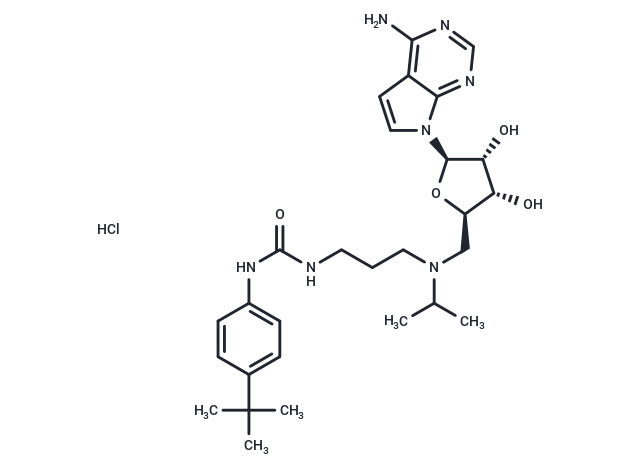Shopping Cart
- Remove All
 Your shopping cart is currently empty
Your shopping cart is currently empty

EPZ004777 hydrochloride (EPZ004777 HCl) is a potent, selective DOT1L inhibitor with IC50 of 0.4 nM.

| Pack Size | Price | Availability | Quantity |
|---|---|---|---|
| 2 mg | $68 | 5 days |
| Description | EPZ004777 hydrochloride (EPZ004777 HCl) is a potent, selective DOT1L inhibitor with IC50 of 0.4 nM. |
| Targets&IC50 | DOT1L:0.4 nM. |
| In vitro | EPZ004777 demonstrates potent, concentration-dependent inhibition of DOT1L enzyme activity with an IC50 of 400±100 pM, displaying remarkable selectivity over other HMTs (PRMT5, 521±137 nM; others, >50 μM). It significantly reduces the viability of MLL-rearranged cell lines, specifically MV4-11 and MOLM-13, while not affecting Jurkat cell growth. A small population of MV4-11 cells remains viable but ceases to divide over longer periods of treatment. At concentrations of 3 μM or greater, EPZ004777 strongly inhibits the proliferation of MLL-AF9-transformed cells and selectively inhibits the proliferation of MLL-AF10 and CALM-AF10 transformed murine bone marrow cells[1][2]. |
| In vivo | EPZ004777 is well tolerated without overt toxicity observed. Complete blood count analysis after 14 days of continuous exposure to EPZ004777 revealed a statistically significant increase in the total white blood cell count, which resulted from an increase in neutrophils, monocytes, and lymphocytes. EPZ004777 (50, 100, or 150 mg/mL) administration is well tolerated, and no significant weight loss is observed[1]. |
| Kinase Assay | Avian (chicken) erythrocyte oligonucleosomes are purified. EPZ004777 is serially diluted 3-fold in DMSO for a total of ten concentrations, beginning at 1 μM. A 1 μL aliquot of each inhibitor dilution is plated in a 384-well microtiter plate. The 100% inhibition control consisted of 2.5 μM final concentration of the product inhibitor S-adenosyl-L-homocysteine, (SAH). Compound is incubated for 30 min with 40 μL per well of 0.25 nM DOT1L(1-416) in assay buffer (20 mM TRIS [pH 8.0] 10 mM NaCl, 0.002% Tween 20, 0.005% Bovine Skin Gelatin, 100 mM KCl, and 0.5 mM DTT). 10 μL per well of substrate mix comprising assay buffer with 200 nM 3H-SAM (80 Ci/mmol), 600 nM unlabeled SAM, and 20 nM nucleosomes are added to initiate the reaction (both substrates are present in the final reaction mixture at their respective KM values, an assay format referred to as "balanced conditions". Reactions are incubated for 120 min and quenched with 10 μL per well of 800 μM SAM. Incorporation of radioactivity into nucleosome substrate is measured in a flashplate. IC50 values for enzymes in the histone methyltransferase panel are determined under similar balanced assay conditions with both SAM and protein/peptide substrate present at concentrations equal to their respective KM values[1]. |
| Cell Research | EPZ004777 is prepared in DMSO (50 or 10 mM) and stored (?20°C), and then diluted with appropriate medium (DMSO 0.2%) before use[1]. For assessment of cell proliferation and viability in human cell lines, exponentially growing cells are plated, in triplicate, in 96-well plates at a density of 3×104 cells/well in a final volume of 150 μL. Cells are incubated in the presence of 3 μM (proliferation curve), or increasing concentrations (IC50 determination) of EPZ004777 up to 50 μM. Viable cell number is determined every 3-4 days for up to 18 days using the Guava Viacount assay and analyzed on a Guava EasyCyte Plus instrument. On days of cell counts, growth media and EPZ004777 are replaced and cells split back to a density of 5×104 cells/well. Total cell number is expressed as split-adjusted viable cells per well. For each cell line, IC50 values are determined from concentration-dependence curves at each time point using Graphpad Prism software. Experiments to determine IC50 values continued until IC50 values stabilized (day 18 for THP-1 cells, day 14 for all other cell lines)[1]. |
| Alias | EPZ004777 HCl |
| Molecular Weight | 576.13 |
| Formula | C28H42ClN7O4 |
| Cas No. | 1380316-03-9 |
| Smiles | Cl.CC(C)N(CCCNC(=O)Nc1ccc(cc1)C(C)(C)C)C[C@H]1O[C@H]([C@H](O)[C@@H]1O)n1ccc2c(N)ncnc12 |
| Relative Density. | no data available |
| Storage | Powder: -20°C for 3 years | In solvent: -80°C for 1 year | Shipping with blue ice. |
| Solubility Information | DMSO: Soluble |

Copyright © 2015-2025 TargetMol Chemicals Inc. All Rights Reserved.